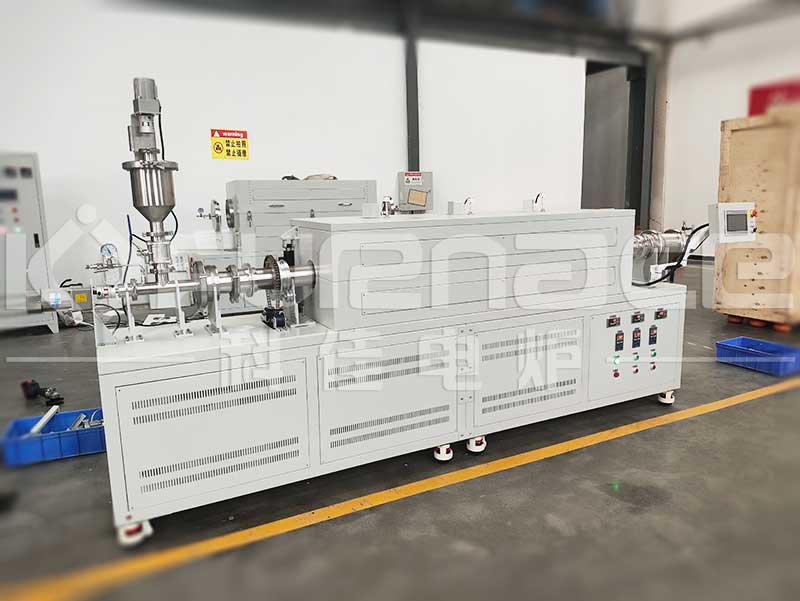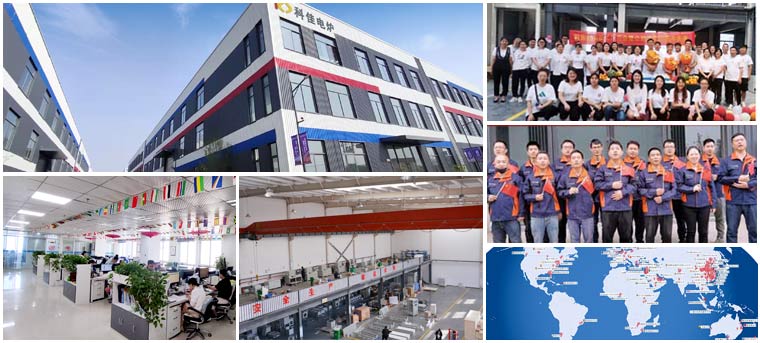Temperature Control Technology and Application Strategy of Rotary Tube Furnace
Temperature control in a rotary tube furnace is crucial for ensuring heat treatment process stability and material quality. Its accuracy directly impacts product performance. The following analysis examines control objectives, key technologies, influencing factors, and optimization solutions. Core objectives and parameters of temperature controlThe temperature control of the rotary tube furnace must be precisely controlled in multiple dimensions to meet the stringent microstructural requirements of electronic components, ceramic materials, etc.:
•Core goal: Accurately control the medium outlet temperature, flow rate and pressure, while maintaining the uniformity of the temperature field in the furnace to ensure that the material completes sintering, annealing and other processes under the set temperature curve.
•Key parameters:
– Temperature control accuracy: Mainstream equipment can reach ±1°C, and some high-precision models support independent control of multiple temperature zones (such as 3-zone 3-point temperature control).
– Heating rate: It can be adjusted according to process requirements, up to 20°C/min (for example, lithium battery materials need to be heated quickly to inhibit grain growth).
– Temperature range: Conventional models cover room temperature to 1800°C, and special scenarios (such as ceramic glaze preparation) require higher temperature ranges.Key technical solutions for temperature controlRotary tube furnaces employ a variety of control strategies, depending on the heating method, fuel type, and process requirements. The following are three common cascade control schemes used in industry:
1. Cascade control of furnace outlet temperature and fuel pressure
•Applicable scenarios: Heating systems based on gas or liquid fuel, especially suitable for working conditions with large fuel pressure fluctuations.
• Working principle:
– Main circuit: The fuel pressure control valve is adjusted based on the feedback signal from the furnace outlet temperature sensor.
– Secondary circuit: monitors fuel main pressure in real time and quickly compensates for pressure fluctuations (such as insufficient heat caused by a sudden drop in gas pressure).
•Advantages: Fast response speed, can effectively overcome fuel pressure interference; pressure measurement is simpler than flow measurement, reducing equipment costs.
2. Cascade control of furnace outlet temperature and furnace temperature
•Applicable scenarios: Double-sloped-top square box rotary tube furnace, which needs to deal with complex interferences such as changes in fuel calorific value and fluctuations in air excess coefficient.
• Working principle:
– Main circuit: The outlet temperature is the final control target (for example, electronic ceramic sintering requires strict control of the cooling rate during the cooling stage).
- Secondary circuit: Through multi-point temperature measurement in the furnace (temperature measurement points with fast response and strong representativeness should be selected), the temperature field distortion in the furnace is compensated in advance.
•Advantages: The secondary circuit can cover various interferences such as fuel composition changes and atomization effects, thereby improving the system's anti-interference ability.

3. Cascade control of furnace outlet temperature and fuel flow
•Applicable scenarios: Processes that require precise measurement of fuel consumption (such as energy consumption statistics for nanomaterial sintering), or when the fuel is a viscous medium such as heavy oil or residual oil.
• Working principle:
– Main circuit: regulates fuel flow according to outlet temperature deviation.
– Secondary circuit: The actual fuel consumption is monitored in real time through the flow meter to avoid overshoot caused by flow sensor lag.
• Note: High fuel flow measurement accuracy is required (e.g., a volumetric flow meter is required for fuel), and regular calibration is required to prevent clogging.Key factors affecting temperature control accuracyIn practical applications, the following parameters need to be comprehensively optimized to ensure effective temperature control, especially in high-precision scenarios such as electronic component manufacturing:
| Interference factors |
Impact Mechanism |
Optimization measures |
| Fluctuations in processing volume |
A sudden increase in feed flow leads to increased heat absorption of the material and a drop in outlet temperature. |
Front flow control link to stabilize the feed rate |
| Changes in fuel composition |
Fluctuations in the methane content in the gas cause changes in calorific value, affecting combustion efficiency |
Adopt calorific value online analyzer to dynamically adjust the air-fuel ratio |
| Flue resistance |
Failure of the induced draft fan leads to poor exhaust, increased furnace pressure, and uneven temperature distribution. |
Add a flue pressure sensor to adjust the speed of the induced draft fan in a coordinated manner |
| Material properties |
High-moisture materials absorb a lot of heat in the initial stage, causing the furnace temperature to drop sharply |
Use segmented temperature control to set different power levels for preheating and sintering stages |
Application and development of intelligent control technologyAs electronic component manufacturing moves towards refinement and intelligence, rotary tube furnace temperature control is integrating multidisciplinary technologies to achieve higher-dimensional precision control:
•Multi-temperature zone coordinated control: Through independent heating of different zones (such as a 3-zone tubular furnace), the temperature requirements of different process sections in the same furnace (such as gradient cooling for crystal annealing) can be met.
•Remote monitoring and adaptive algorithms: Combined with IoT technology, the temperature curve is tracked in real time through a computer cloud platform (such as remote diagnosis of temperature control deviations), and AI algorithms are used to optimize PID parameters to adapt to differences in material batches.
•Atmosphere-temperature coupling control: When introducing protective gases such as nitrogen and argon, the gas flow and temperature curve are adjusted synchronously to avoid fluctuations in heat conduction efficiency caused by atmosphere changes (for example, the sintering of lithium battery positive electrode material LiCoO₂ requires coordinated control of oxygen partial pressure and temperature).
SummarizeTemperature control technology for rotary tube furnaces is key to ensuring product consistency in electronic component manufacturing. Through cascade control and multi-parameter collaborative optimization, it effectively addresses complex interference in industrial settings. In the future, as the new energy and semiconductor industries demand higher material performance, high-precision multi-temperature zone control, intelligent adaptive regulation, and coordinated atmosphere-temperature-pressure control will become mainstream technological developments, further solidifying its key position in high-end manufacturing. ![]() Send E-mail:web@kejiafurnace.com
Send E-mail:web@kejiafurnace.com![]() Wechat/Whatsapp: +86 18037178440
Wechat/Whatsapp: +86 18037178440![]() Company Tell: +(86)18037178440
Company Tell: +(86)18037178440

 E-mail:web@kejiafurnace.com
E-mail:web@kejiafurnace.com
 Tell:+(86) 18037178440
Tell:+(86) 18037178440
 Whatapp:+(86) 180-3717-8440
Whatapp:+(86) 180-3717-8440
 Address:Room 1505, Building 9, No. 26 Dongqing Street, Zhengzhou High-tech Industrial Development Zone
Address:Room 1505, Building 9, No. 26 Dongqing Street, Zhengzhou High-tech Industrial Development Zone


 Website navigation
Website navigation
 Position:
Position:





